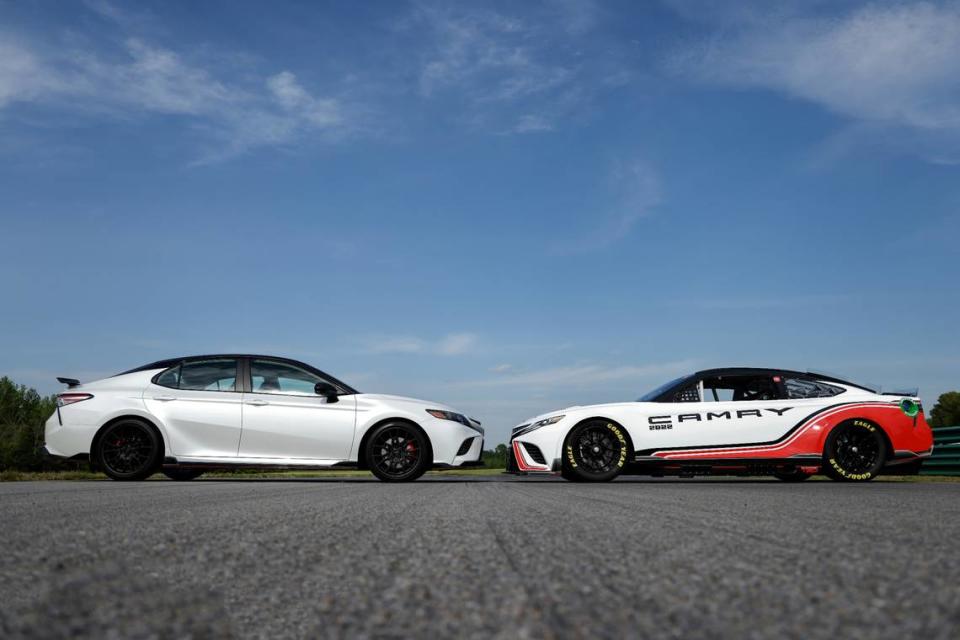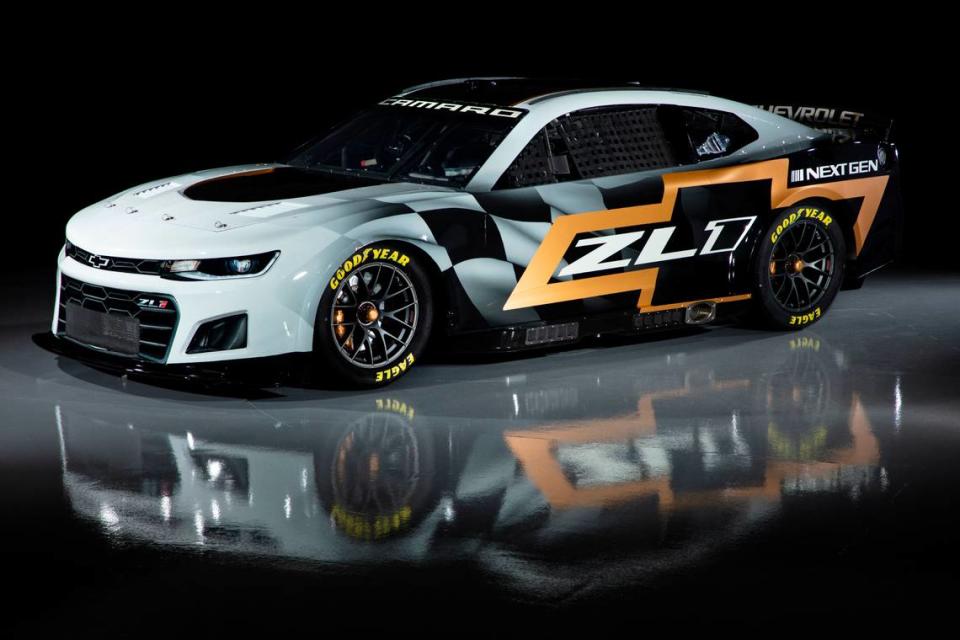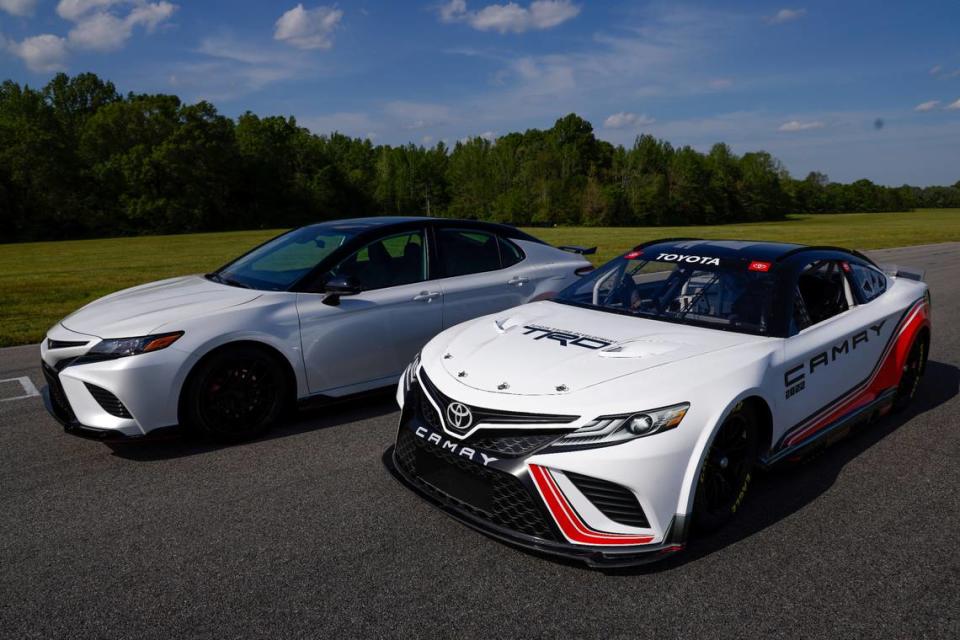First look at NASCAR’s Next Gen car: It’s the Toyota, Ford and Chevrolet of the sport’s future
Toyota Racing Development president David Wilson referenced a tongue-in-cheek joke among NASCAR industry insiders: Who would be foolish enough to buy into NASCAR with the current car that we’re racing?
“And the answer is nobody,” Wilson said, referring to the high competition, production and development costs of fielding top-tier stock cars weekly.
“The reason that Denny Hamlin and Michael Jordan partnered up to start a racing team is because of one thing: Next Gen,” Wilson said. “These are successful business people — not just athletes.”
The new car is promising to revolutionize the NASCAR industry and its business model, and the start of that revolution is nearly here. The sport’s three manufacturers, Toyota, Ford and Chevrolet, unveiled their new car bodies, specs and elements Wednesday afternoon in Charlotte. The new car will debut on track in competition at the Daytona 500 in February.
In addition to the cost-cutting benefits that are expected to come from manufacturer-built chassis, as well as parts and composite bodies supplied to teams by manufacturers rather than through various suppliers, the Next Gen car on the outside will look more similar to a showroom car than ever before. NASCAR president Steve Phelps said the the new model is designed to “put the stock back in stock car racing.”
“That’s what the styling does,” Phelps said. “That’s what the relevance does, and so that was the important thing for us.”

Toyota Racing Development executive engineer Andy Graves said that achieving close semblance of the car’s production counterpart was an intentional feature of the race car body styling. TRD collaborated with longtime partner Calty Design on the body design modifications, which includes a greenhouse shape, shorter proportions with less overhang and aerial symmetry on both sides.
“We’ve always done a good job on the front, on the nose of the car to be able to capture the identity of the Camry,” Graves said. “But now with the sides, we’ve been able to really increase the production look.”
“It’s very exciting for us to have a car that’s much more representative of what we sell in the showroom,” he said.
Changes on the inside of the car are significant. Specifications of the new car compared to the current Gen-6 model include larger 18-inch wheels (they’re now 15 inches), a new transaxle that combines the transmission and rear gears into one package and independent rear suspension, which is standard for all three manufacturers.

Additionally, the bottom of the car will be sealed with an underwing and rear diffuser (think Porsche GT3), the chassis has been redesigned to feature new front and rear bumpers with both clips bolting onto the center section of the vehicle, and the car will utilize a composite body. Under the hood, updates include a longer airbox, new engine intake from the grille area and hood exits to help with engine cooling.
There are also developments in the new car model aimed at improving driver safety, including additional roll bars, foam inserts between the chassis and nose and tail of the car to increase cushioning upon impact, drivers positioned slightly closer to the center of car, and updated hood flaps and roof flaps to keep the cars on ground at higher rates of speed.
“The car has all the technology that we’ve poured into our current car plus some,” Chip Ganassi Racing Chevrolet driver Kurt Busch said Wednesday.
Busch tested a “P3” model of the car with an ECR engine at the Charlotte roval and oval in November. He mentioned that the new car looks more “rigid” and includes crash-absorbing materials, as well as systems in the front and rear of the car that make it easier to bolt back together after an accident.
“So you save a lot of the car after a wreck,” Busch said. “Similar to a bulkhead system in IndyCar.”
The most notable other changes for drivers will be a transition to a five-speed sequential shift for the transmission instead of the H-pattern gearbox, as well as larger brakes.
On the competition side, Toyota indicated that the Next Gen car will utilize a 670 horsepower or 550 horsepower package, depending on the track, which is less power than the current 750 horsepower package at short tracks. NASCAR said Wednesday that specific aero and engine packages have not yet been determined.
“We’re within a window where the industry is comfortable with,” NASCAR chief racing development officer Steve O’Donnell said. “We know that we can take that to future technologies as well, so we’ll be somewhat close to where we’re at today but still not finalized.”
O’Donnell also said Wednesday that there are more planned tests for Next Gen with multiple cars on the track. Those tests will take place in August at Daytona, in October at the Charlotte road course and oval and at Phoenix after the 2021 season ends. He also listed various categories NASCAR will use to measure the success of its next car, including safety, the number of competitive teams, the number of different leaders, the number of different winners and whether all OEMs are able to be competitive.
“And then longer term, what is this doing for ownership?” O’Donnell said. “Not only for our existing owners but potentially new owners.”
Graves said the impending changes in the Cup Series could impact the future of lower series, as well. He said he sees the benefit of the lower horsepower creating future synergies with the Xfinity and Truck Series since those utilize a similar package.
“We would like to have the opportunity to be able to bring them down into Xfinity or even get back into OEM engines in the Truck Series,” Graves said. “So we felt like this is a great time to align that and create some synergies there that hopefully we can take advantage of in the future.”

“Future” is the operative word with Next Gen, as the car also is package-protected for electrification and hybridization, meaning it is designed with space to add an electric motor and battery.
“We don’t want to get down the road two or three years from now and decide, ‘Hey, we want to add a battery. We want to add more electrification, hybrid, whatever form that is,’” Wilson said. “And it requires us to do a complete tear up.”
Wilson said that would run counter to the intention behind Next Gen of saving teams money and lowering costs to compete. He also noted other relevant stakeholders that might get overlooked in the unveiling of the car designed to improve NASCAR’s business model: the fans. He described his “healthy anxiety” for Next Gen’s true test on the track in February at the Daytona 500, the sport’s largest spectacle.
“Toyota is not in NASCAR because of technology,” Wilson said. “It’s not a technology play. Yes, it’s important. Yes, relevancy is important, but if we can’t fill the grandstands and put on a good show, none of that matters because we don’t have a sport in the end.”
“Undoubtedly we’re gonna find some things that we’re going to have to address on the fly,” Wilson continued. “... And that’s a little unnerving. I’m the first to say that’s a little intimidating, but it’s exciting as well.”
Specifications for the NASCAR Next Gen car
Overall Length: 193.4”
Overall Height: 50.4”
Width: 78.4”
Wheelbase: 110”
Wheels: 18” x 12” forged aluminum
Weight: ~3,300 lbs.
Transmission: 5-speed sequential shift
Fuel Cell: ~20 gallons (Sunoco Green E15)

